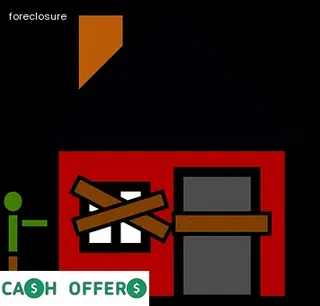Preforeclosure is a period of time where the borrower has defaulted on their loan and the lender has begun the process of repossessing their property. It is important to be aware of the timeline for preforeclosure in Connecticut, as this can vary depending on what type of loan was taken out.
Generally, preforeclosure begins when an initial Notice of Default letter is sent to the borrower, notifying them that they have become delinquent on payments. This is followed by a 90-day period during which the parties must attempt to negotiate a solution or repayment plan; however, if no agreement is reached after this time period then legal proceedings may begin.
During this time, lenders can also sell off any available assets belonging to the borrower in order to recoup some of the unpaid debt. Finally, if all efforts fail then foreclosure proceedings can be initiated and a foreclosure sale will be held.
Knowing the preforeclosure timeline in Connecticut is essential for both borrowers and lenders so that they can better understand their rights and obligations throughout this process.

In Connecticut, there are many types of assistance available to those facing foreclosure. The Connecticut Housing Finance Authority provides loans for homeowners that have experienced a hardship, such as job loss, medical bills, or reduced income.
Additionally, the Connecticut Foreclosure Mediation Program enables borrowers to enter into mediation with their lenders in an effort to avoid foreclosure. Local governments may also offer counseling and legal services to those in need of help understanding the foreclosure process and their rights.
Finally, some nonprofit organizations provide grants and other forms of financial support to homeowners facing foreclosure. Whether it be through loan programs, legal assistance, counseling services or financial aid from nonprofits, those facing foreclosure have a variety of options for assistance in Connecticut.
Navigating foreclosure can be an overwhelming and difficult process. Fortunately, there are legal resources available to help those facing foreclosure in Connecticut.
For starters, the Connecticut Judicial Branch offers a comprehensive overview of the foreclosure process and timeline in their Foreclosure Mediation Program guide. This resource provides detailed information about the steps involved in a foreclosure, including how long each step takes, what happens if homeowners don’t respond to notices from the lender, and how to request mediation.
In addition, Connecticut Legal Services provides free or low-cost legal assistance to individuals facing foreclosure. Their website also includes a number of helpful resources such as sample letters and forms that can help homeowners during the foreclosure process.
Finally, homeowners should consider consulting with an experienced real estate attorney who is knowledgeable about Connecticut’s foreclosure laws and can provide valuable advice on how best to protect their rights throughout the process.

Connecticut's preforeclosure period is a crucial time for homeowners facing foreclosure. During this time, it is important to understand the timeline of events that will take place and what can be done to protect the home.
The homeowner should begin by working with their bank or lender to negotiate a solution that meets both parties' needs. If negotiations are successful, then the homeowner may be able to avoid foreclosure altogether.
However, if foreclosure cannot be avoided, it is important to know when the process will begin and end in order to make sure all of the homeowner's rights are respected. Once foreclosure proceedings have begun, there are deadlines for filing paperwork and attending hearings in order to remain compliant with Connecticut law.
Additionally, understanding the various types of foreclosures available in Connecticut is essential for making informed decisions when facing foreclosure. Knowing what options exist may help homeowners find an alternative they can live with while minimizing financial losses.
Additionally, staying informed on any changes to legislation or court rulings related to foreclosures in Connecticut can help homeowners protect their rights throughout every stage of preforeclosure and beyond.
A breach letter is an essential document in the foreclosure process for homeowners in Connecticut. It is a formal, written notification from the lender to the borrower indicating that they are in default of their mortgage contract.
This type of letter outlines how much money is owed and how long the homeowner has to make payments before foreclosure proceedings begin. It also includes a statement of rights outlining what happens if the homeowner fails to meet their obligations.
It's important to understand that this letter does not necessarily mean foreclosure proceedings will begin immediately; however, it does serve as a warning that foreclosure is a potential outcome if payments are not made on time. Receiving a breach letter can be scary and intimidating, but homeowners should take comfort knowing that they have options and rights regarding their home loan and the foreclosure process.

It is important to be aware of the signs of impending foreclosure so that you can take action quickly. Foreclosure proceedings in Connecticut begin when a homeowner misses one or more mortgage payments.
If a payment is missed, the homeowner will receive a notification from their lender stating that they are in delinquency and must take action to avoid foreclosure. Other signs of potential foreclosure include increased contact from the lender, such as letters or phone calls, as well as a Notice of Default being issued by the lender.
In Connecticut, homeowners have 90 days to pay off their delinquent debt before the Notice of Default is recorded with the town clerk and foreclosure proceedings become official. It is vitally important for homeowners to stay informed about their financial situation in order to avoid facing foreclosure.
The impact of foreclosure on credit scores is significant and can have long lasting effects. Foreclosure can lead to a decrease in credit score by as much as 200 points, depending on the individual's financial situation prior to foreclosure.
Although it does take time for a credit score to recover from foreclosure, there are ways to minimize the damage. Staying current on all existing debt obligations, such as car loans or credit card payments, can help rebuild credit faster.
Additionally, consumers should understand the foreclosure timeline associated with their state of residence. In Connecticut, lenders must provide written notice of default before they can proceed with the foreclosure process.
The homeowner then has ninety days to either cure the default or return possession of the property to the lender before the lender can file a complaint in court and proceed with a judicial foreclosure sale. This timeline is important for homeowners facing foreclosure in Connecticut so that they may make informed decisions about their options and work toward rebuilding their credit score.

Default and repossession are two of the most important steps in the foreclosure timeline in Connecticut. When a homeowner fails to make their mortgage payments, they enter into default and this is the first step towards foreclosure.
At this point, lenders will usually contact the homeowners to try and resolve the situation, so it is important for homeowners to respond promptly. If no resolution can be made, then the lender can move forward with repossession by taking possession of the property.
Repossession must be done legally, however, as there are specific procedures that must be followed in order to avoid legal action from the homeowner. Understanding these procedures is key for homeowners facing foreclosure so they know what steps to take and when.
It is also important for those considering buying a foreclosed home to understand default and repossession in order to ensure that all legal requirements have been met before going through with the purchase.
When facing foreclosure, homeowners in Connecticut have several options available to them that may help to avoid the process. Loan modification is an effective strategy for most homeowners and is one of the most common solutions for avoiding foreclosure.
This strategy works by restructuring the loan terms so that the payments are more affordable and manageable for the homeowner. The first step in this process is to review your current mortgage agreement, determine what can be changed, contact your lender to discuss possible modifications, apply for loan modification, and then receive a response from your lender.
It’s important to remember that while loan modification can be effective in certain circumstances, it’s not guaranteed to work as lenders do not have an obligation to modify loans even if you meet all requirements. Therefore, it’s essential to also explore other potential solutions such as forbearance agreements or repayment plans with your lender if you want to avoid foreclosure.

When it comes to foreclosure in Connecticut, there are a variety of tax implications that must be taken into consideration. Foreclosure can result in additional taxes being imposed on the homeowner, including capital gains taxes and recapture taxes.
Capital gains taxes are imposed if the home sold for more than was originally paid when purchasing the property and these must be paid by the homeowner. Recapture taxes may also be levied if certain credits were taken when buying the home such as energy efficient credits or mortgage interest deductions.
It is important to understand these tax implications before entering into foreclosure proceedings. Furthermore, understanding the timeline of foreclosures in Connecticut is essential for a successful outcome.
In many cases, homeowners have a few years to find a solution before their property is foreclosed upon; however, this timeline varies depending on the type of loan involved and whether it was secured through a private lender or government entity. A comprehensive guide to foreclosure timelines in Connecticut can help provide an overview of what to expect throughout the process and ensure taxpayers understand how much time they have to take action before legal action is taken against them.
The Connecticut judicial foreclosure process can be a complicated and lengthy process. Homeowners facing foreclosure in Connecticut should be aware of the timeline involved, which includes pre-foreclosure processes and post-foreclosure proceedings.
Pre-foreclosure activities include the lender initiating legal action by filing a complaint with the court and issuing notice to the homeowner. The homeowner then has an opportunity to respond to the complaint before the court issues a judgment of foreclosure.
After that, there is a redemption period when the homeowner has an opportunity to redeem their loan by paying off past due amounts and other costs associated with the foreclosure process. Once this period is over and if no redemption occurs, a sale date is set for a public auction where prospective buyers may bid on the property.
If no bids are successful, the lender may purchase the property at its minimum bid price. Finally, there is a post-sale process that includes delivery of possession of the property to the successful bidder or lender, confirmation of title transfer in certain cases, and issuance of deed when all requirements are met.

In Connecticut, there are two main types of foreclosure: nonjudicial and judicial. Nonjudicial foreclosures take place outside of court and involve the homeowner forfeiting their rights to the property.
This type of foreclosure is usually done through a power of sale clause in the mortgage or deed of trust. The lender will then be able to sell the property at public auction.
On the other hand, judicial foreclosures occur when a court order is obtained by the lender in order to regain possession of the property. This typically happens when a homeowner fails to make payments on their mortgage or deed of trust for a period of time.
The court must first grant permission for the lender to proceed with selling the property before it can take place. The timeline for each type of foreclosure varies depending on many factors, such as whether it's nonjudicial or judicial, how long a homeowner has been delinquent on payments, and any applicable laws in Connecticut that may play into effect.
Understanding these differences is key for anyone facing a potential foreclosure in Connecticut.
In Connecticut, when a homeowner is facing foreclosure, there are options available to avoid the process. A homeowner can negotiate with their lender to enter into a repayment plan or loan modification agreement such as extending the loan’s term or reducing the interest rate.
Other options include forbearance or short sale agreements, where the lender agrees to reduce the amount owed on the loan or accept a lesser amount in exchange for releasing the lien on the property. Additionally, homeowners may be eligible for government-sponsored programs that provide assistance to those who have been affected by economic hardship.
Understanding these alternatives and working with attorneys and housing counselors can help homeowners explore strategies and make informed decisions about how best to manage their situation. Foreclosure timelines will vary depending on whether homeowners are able to come to an agreement with their lenders and/or if they choose to pursue legal action.

Short sales can be a viable option for avoiding a full-foreclosure process. Investigating this alternative should be an important step in any comprehensive guide to foreclosure timelines in Connecticut.
A short sale is when a lender agrees to accept less than the total amount of debt owed by the homeowner. This reduces the financial burden on the homeowner and allows them to avoid going through a full foreclosure process.
There are some key steps that need to be taken in order to make sure that the short sale is completed properly. The homeowner must first get approval from their lender and then negotiate with potential buyers to determine how much they are willing to pay for the property.
They also need to prepare all necessary paperwork and make sure it is submitted correctly, as well as obtaining approval from both local and state governments for the transaction. In addition, homeowners need to be aware of any tax implications or legal risks associated with short sales before pursuing them as an option.
Understanding these factors and taking all necessary steps can help ensure that homeowners are able to complete their short sales successfully and on time.
Deed-in-lieu options are a viable preforeclosure tool for Connecticut homeowners, offering them the opportunity to avoid foreclosure. Before evaluating this option, it is important for homeowners to be aware of the timeline associated with preforeclosure proceedings.
Understanding when and how the foreclosure process starts and ends will help homeowners make informed decisions and better assess their deed-in-lieu options. The time frame begins when a delinquency notice is sent by the lender informing the homeowner that they have defaulted on their mortgage payment obligations.
This notice triggers a 90-day period in which a homeowner has an opportunity to cure their delinquency or work out an alternative arrangement with the lender, such as a deed-in-lieu agreement. If no arrangement is reached during this period, another 90 days is provided for the lender to file a foreclosure complaint against the homeowner.
During this time, however, lenders may still accept a deed in lieu of foreclosure if all parties agree on terms. Once the complaint has been filed, another 45 days will pass until a final judgment is issued by the court whereupon a sheriff's sale date is set which marks the end of the foreclosure timeline in Connecticut.

In Connecticut, when a lender files a lawsuit for judicial foreclosure, the homeowner has options to dismiss or reinstate the lawsuit. Though Connecticut does not require a specific timeline for dismissal, the courts will usually enter an Order of Dismissal if no action is taken by the homeowner within six months from the date of filing.
Some cases may be dismissed with prejudice, which prevents it from being refiled in the future. Alternatively, if homeowners choose to reinstate the lawsuit, they must pay all past-due mortgage payments (including late fees and attorneys' fees), as well as any additional costs associated with the foreclosure process.
The court will then reinstate the case and set a new hearing date. It is important to note that this process must occur before the judge enters a judgment of foreclosure in order to be successful.
Homeowners should consult experienced legal counsel to understand their rights and obligations associated with dismissing or reinstating a lawsuit for judicial foreclosure in Connecticut.
When a home is foreclosed in Connecticut, there are certain rights that the homeowner has after the foreclosure is complete. These post-foreclosure redemption rights can be complicated, so it’s important for homeowners to understand what they are and how they might be able to take advantage of them.
In Connecticut, homeowners have the right to redeem their property within three months of the foreclosure sale by paying off any outstanding mortgage debt, taxes, costs associated with the foreclosure process, and any other liens on the property. This period is known as the redemption period and homeowners may also be able to get assistance from local or state government agencies during this time.
After this period ends and if no redemption has been made, ownership of the property passes to either a third-party buyer or a lender if there was none at the foreclosure sale. Homeowners also have certain rights related to personal items left on the property after foreclosure including being given sufficient notice before being removed from the premises and having access to remove their possessions without penalty.
Understanding these rights is essential for anyone who is facing foreclosure in Connecticut as they will help ensure that they receive all of their belongings and know how long they have to make payments on any remaining debt associated with their former residence.
In Connecticut, foreclosure timelines vary based on the circumstances of each individual case. Generally, homeowners in foreclosure can remain in their home until the foreclosure process is complete and they are legally required to vacate.
As a homeowner in foreclosure, it is important to understand the timeline of events that will occur as part of the process. In most cases, you will receive a Notice of Default from your lender after missing three consecutive mortgage payments.
This notice will provide information about how long you have before your lender can take legal action to foreclose on your home. After receiving the Notice of Default, you typically have 3-4 months to cure the default or negotiate an alternative solution with your lender.
Alternatively, if you are unable to reach a resolution with your lender during this period, the lender may file a Lis Pendens (Notice of Intent) with the court which begins the foreclosure process. The Lis Pendens typically gives homeowners an additional 2-3 months to work out an agreement before they must vacate their home upon completion of the foreclosure process.
It is important to note that these timeframes may vary depending on factors such as whether you’ve filed for bankruptcy or if your loan was securitized by Fannie Mae or Freddie Mac. Understanding these timelines and staying informed throughout all stages of the process can help ensure that you are able to remain in your home until it is time for you to move out due to legal requirements.

Foreclosure in Connecticut is a legal process that begins when a homeowner fails to make mortgage payments and ends with the transfer of ownership of the home. It's important to understand the timeline of foreclosure proceedings in order to protect your rights as a homeowner. This comprehensive guide will provide you with an overview of the steps involved in Connecticut foreclosure proceedings, so you can take action before it's too late.
The first step in the foreclosure process is for the lender (mortgage servicer) to send a Notice of Default or Lis Pendens to the borrower. This notice informs them that they are behind on their mortgage payments and must either pay up or risk losing their home. If no payment is made, then the second step occurs which is when the lender files a lawsuit against the borrower seeking to foreclose on the property.
Once this lawsuit is filed, there are several more steps that must be completed before ownership is officially transferred from the borrower to the lender. These include: ordering an appraisal and title search, publishing notices in local newspapers, scheduling hearings and finally completing a foreclosure sale at auction if necessary. It is important for homeowners to stay informed throughout these proceedings by attending hearings and reading published notices closely.
Finally, once all steps have been completed successfully and ownership has been transferred from the borrower to lender, this marks an end to Connecticut foreclosure proceedings. Homeowners should be aware that they may still owe money after foreclosure due to deficiency judgments, as well as any additional costs associated with selling their home at auction. Being informed about each step of Connecticut’s foreclosure process can help homeowners protect themselves during such challenging times.
Stopping a foreclosure in Connecticut can be difficult, but it is not impossible. Knowing the timelines and taking advantage of legal protections offered by the state will help homeowners in foreclosure avoid or delay a sale.
In order to stop a foreclosure, borrowers need to act quickly, as timelines can be strict. Generally speaking, borrowers should start by contacting their lender immediately when they realize they are behind on payments and provide evidence that they have enough funds to make up the arrears.
Borrowers may also consider filing for bankruptcy, which can halt a foreclosure or allow more time for an alternative solution. Additionally, homeowners can explore options such as loan modification or refinancing that might help them bring their mortgage current.
Homeowners should also be aware of their rights under the Connecticut Foreclosure Mediation Program, which provides access to free mediation services and other resources to help borrowers avoid foreclosure. Ultimately, understanding all of the options available to avoid foreclosure is key in stopping a foreclosure in Connecticut.
Foreclosure is a scary prospect, particularly in Connecticut, where the timeline for foreclosure can be quite long. To understand how far behind on payments you must be before entering foreclosure, it's important to know exactly what a foreclosure timeline looks like in Connecticut.
Generally speaking, borrowers must be at least four months behind on their mortgage payments in order to enter into the foreclosure process. After this time has elapsed, the lender may file a notice of intent to foreclose with the court, which kicks off a 90-day period during which the borrower may attempt to catch up on missed payments or work out an alternate solution with the lender.
If no resolution is reached by the end of this 90-day timeframe, then the lender may proceed with a public auction and sell off the home to satisfy the overdue debt. This entire process generally takes between 12 and 18 months from start to finish.
While this timeline will vary depending on each particular case and its unique circumstances, it's important for Connecticut borrowers and homeowners to remain aware of how much time they have before facing foreclosure proceedings and potential eviction from their homes.